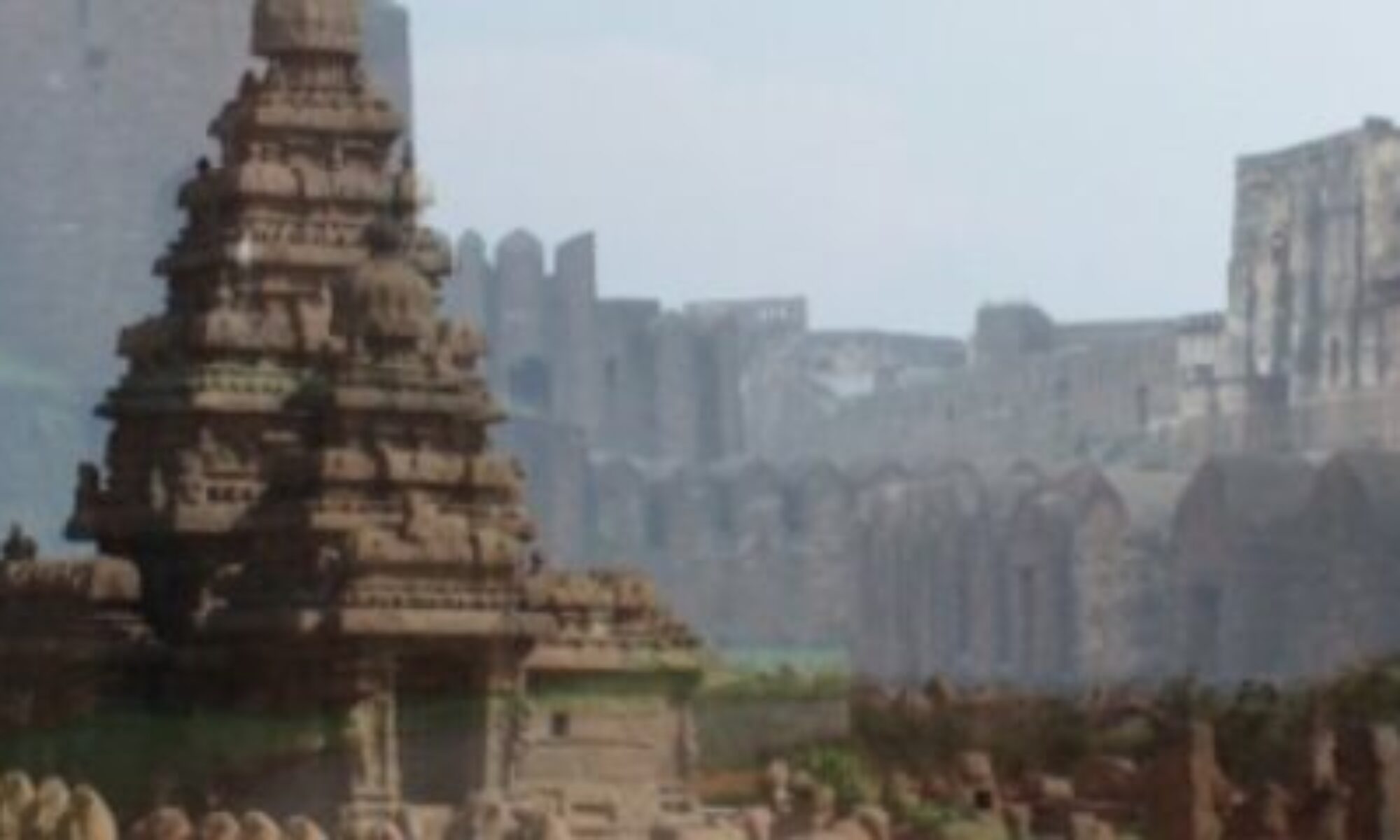There ar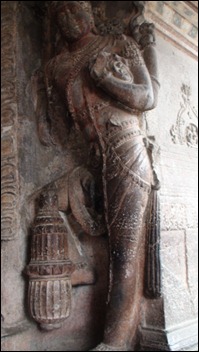 e six windows to the Great Hall, two in front and two on each side, of which the one on the South-East is broken. Two of the windows are formed as a combination of animal and vegetable designs. They may seem scarcely adequate for the purpose for which they were indented, but as light also enters from the five doors, it is sufficient to dispel the darkness in the corners of the hall, as far as really necessary in a typical Indian temple.
e six windows to the Great Hall, two in front and two on each side, of which the one on the South-East is broken. Two of the windows are formed as a combination of animal and vegetable designs. They may seem scarcely adequate for the purpose for which they were indented, but as light also enters from the five doors, it is sufficient to dispel the darkness in the corners of the hall, as far as really necessary in a typical Indian temple. 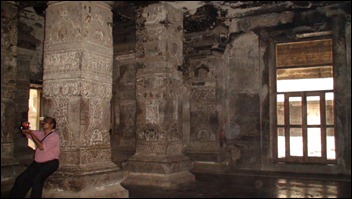
The main door is guarded by gigantic Saiva dwarapalas, leaning on heavy maces.The hall, 57 feet wide by 55 deep, as a wide central and cross aisle, while in each corner thus formed square columns to support the roof. The four pillars in the center are exquisitely carved with different designs while the other sixteen are of the general type. At each end of the cross aisle is a door leading to a side balcony, with two pillars in front of it richly carved in florid ornamentation. 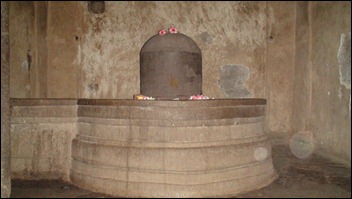
At the end of the hall is the vestibule of this shrine. On the roof is Lakshmi or Annapurna standing on a lotus with a high head-dress. Brahma squats at her right elbow, Vishnu at her left with gandharvas at the corners of the sculpture. On the north wall of the vestibule is depicted Siva and Parvati playing the dice game, now almost completely destroyed. The dwarapalas were females, probably Ganga and Yamuna, one on a makara and the other on a tortoise, but the heads of both have been destroyed.
The s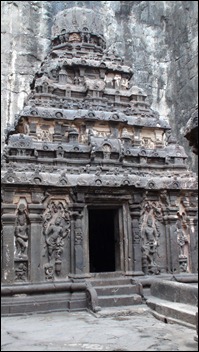 hrine is a plain cell 15 feet square inside, with a large rosette on the roof. The present altar is modern. It has a large linga. What originally occupied inside is uncertain; it was probably a linga shrine from the beginning, though the female dwarapalas might suggest that it was dedicated to one of the forms of Parvati or Bhavani.
hrine is a plain cell 15 feet square inside, with a large rosette on the roof. The present altar is modern. It has a large linga. What originally occupied inside is uncertain; it was probably a linga shrine from the beginning, though the female dwarapalas might suggest that it was dedicated to one of the forms of Parvati or Bhavani.
The door in each of the back corners of the hall leads to a terrace behind, on which a wide path leads quite round the outside of the shrine, which forms the base of the vimana. The vimana rises to a height of 96 feet from the court below, and is all elaborately carved. Below are ` compartments between pilasters, with richly carved finials over each, and center of each com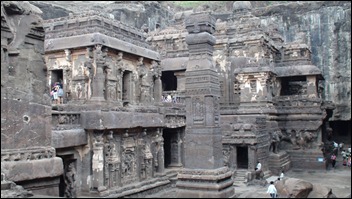 partment is occupied in most cases by some form of Siva or Vishnu. On the wall above these are flying figures, and over them the horizontal moldings of the vimana begin. The base of the vimana is carved in six panels on each side containing various forms of Siva, Vishnu and Parvati. At the upper corners of the panels are conventionalized figures of peacocks with long tails; and above the panel is a Devi sitting cross-legged. Over the gopuram were fat dwarf figures represented as blowing conches. But as they have been carved separately, m
partment is occupied in most cases by some form of Siva or Vishnu. On the wall above these are flying figures, and over them the horizontal moldings of the vimana begin. The base of the vimana is carved in six panels on each side containing various forms of Siva, Vishnu and Parvati. At the upper corners of the panels are conventionalized figures of peacocks with long tails; and above the panel is a Devi sitting cross-legged. Over the gopuram were fat dwarf figures represented as blowing conches. But as they have been carved separately, m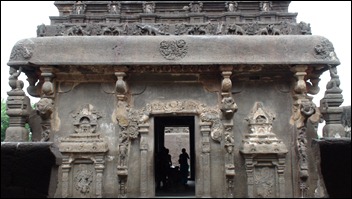 ost of them have been thrown and destroyed. Similar caves are also found in the Dasavatara Cave and also the Undavalli Caves in Andhra Pradesh. On the outer side of the platform are five small shrines in four of which are altars as if for the worship of Goddesses; the fifth is empty. In the empty shrine, there is a bench round the back and ends, and it was probably devoted to the Sapta Matris. It should be noted that while other Brahmanical cave temples here have a clear passage for circumambulation, in the Kailasa this is provided for the by the doors leading to the terrace.
ost of them have been thrown and destroyed. Similar caves are also found in the Dasavatara Cave and also the Undavalli Caves in Andhra Pradesh. On the outer side of the platform are five small shrines in four of which are altars as if for the worship of Goddesses; the fifth is empty. In the empty shrine, there is a bench round the back and ends, and it was probably devoted to the Sapta Matris. It should be noted that while other Brahmanical cave temples here have a clear passage for circumambulation, in the Kailasa this is provided for the by the doors leading to the terrace.
Returning to the entrance of the hall we find, across the bridge outside the porch a small pavilion with four doors and a broken Nandi in it. It is probably not the original, for this is but a small bull; and beyond this to the west are a number of chambers over the entrance porch. There are still traces of 10th Cen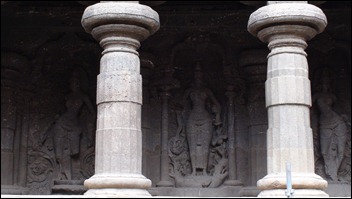 tury paintings on the ceiling of the porch. From these there is access to the roof of the small chambers in front of the court, from which good views along each side of the great temple can be had. Personally, this porch and the central chamber is memorable to me as it was here, a photograph was taken of my family for the first time 15 years ago.
tury paintings on the ceiling of the porch. From these there is access to the roof of the small chambers in front of the court, from which good views along each side of the great temple can be had. Personally, this porch and the central chamber is memorable to me as it was here, a photograph was taken of my family for the first time 15 years ago.
Now coming down to the basement and the last series of panels can be called as the merger of the three sacred rivers Ganga, Yamuna and Saraswati. This is depicted in the cave to the left of the main entrance. Ganga on the makara with lotus leaves and petals behind her, Yamuna on the tortoise with creepers and water plants behind her and Saraswati on a full blown lotus with creepers and birds among the leaves and branches.
We have come to the end of journey of a marvelous cave and no words are enough to describe. We now move on to Cave 17.
